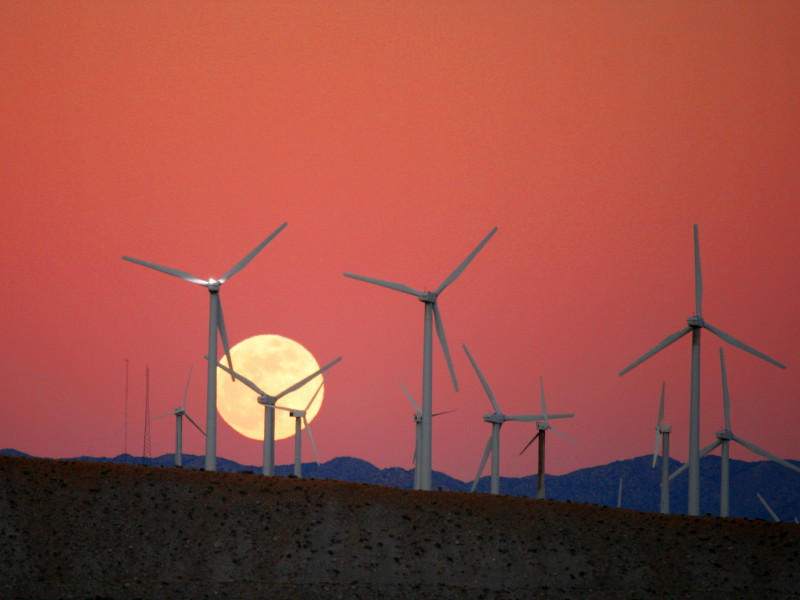

If you comb the ground beneath a wind turbine, you may not find anything out of the ordinary. Dead birds or bats are hard to find, especially considering the huge ground footprint of a wind turbine’s spinning blades. But this belies wind farms’ very real danger to migratory animals. Wind turbines kill a rather staggering 600,000 to 900,000 bats every year, according to a new study. But this does not mean we should start shutting down wind farms.
Dead bats have been found at almost every wind energy facility where someone has looked for them, and researchers have tried to use these numbers to estimate how many bats die every year. Mark Hayes, a postdoctoral researcher at the University of Colorado at Denver, analyzed published findings and places the number at more than 600,000. This number is probably conservative, he says in a new paper published in the December issue of the journal BioScience.
Though most of us think of bats as living in caves, many species roost in trees instead, and migrate across the continent in the fall to mate. These species include the hoary bat, which live alone as adults until mating season, when they travel in groups of hundreds.
“These bats migrate sometimes very long distances, from the Atlantic coast — Georgia, for example — up into the Great Plains,” Hayes said in an interview last week. “We don’t know a lot about their migratory patterns yet, but we’re studying it. They’re small and nocturnal, so we know much less about them than songbirds or butterflies, that sort of thing.”

Hoary bats in particular use trees as landmarks, and biologists hypothesize that males might pick out the tallest tree around, circling it and calling for a mate.
“In many cases, the tallest tree on the landscape, or what looks like the tallest tree, is a wind turbine tower,” Hayes said. “So they’re using them to try to call in females. As they go through that process, they may either not be aware that these blades are rotating, or they may be distracted.”
Distracted is putting it mildly. Hayes once heard a story about a pair of mating bats that fell out of the sky in flagrante delicto, too caught up in their activities to realize they were no longer flying. “They get very distracted during this process,” Hayes said. “It may be one of the things that contributes to this.”
Wind turbines can kill bats in two ways: Blunt force and what’s called barotrauma. A tiny bat stands no chance against a turbine blade two train cars long, whirling at 150 MPH. Even if the bat isn’t struck, spinning turbines create changes in air pressure as they move, which can essentially cause the animals’ lungs to explode. But barotrauma may be less deadly than some biologists think, according to an analysis by the National Renewable Energy Laboratory.
All of this is not to say wind turbines are inherently bad or that we should stop building them. Hayes is emphatic that most biologists, himself included, support wind energy production. “It reduces carbon emissions, pollution, provides jobs and economic growth, so I see it as a net positive,” he said. “But at the same time, I think we have something of a responsibility to keep an eye on what’s happening.”
It may be very easy to have it both ways.

Wind turbines generally turn on when the wind blows at a given speed, often around 3.5 meters per second (about 7.8 mph). This is known as the cut-in speed. Bats don’t like to fly when it’s windy, so wind farms may be able to slash bat fatalities by simply increasing cut-in speeds. A 2010 study by Bat Conservation International (PDF) showed faster cut-in speeds could reduce bat fatalities by 43 to 93 percent, with comparatively minimal losses in power generation. Reducing cut-in speeds during, say, a 6-week period during fall migration could therefore save hundreds of thousands of bats.
More studies have to be done to determine the optimal cut-in speeds and other factors, and exactly where the bats’ migration patterns might intersect wind farms — not to mention how many bats will be flying by. Biologists have no idea how many bats live in North America, within an order of magnitude. This makes conservation more difficult, to say the least.
“If you tried to ask me, ‘How many hoary bats are there?’ I wouldn’t even hazard a guess. It’s a difficult situation to be in,” Hayes said. “We’re starting to get a sense of how many bats are being killed, but we don’t know what proportion of the population that represents. Is it 1 percent, 5 percent, 0.1 percent? We don’t know. Given that we don’t know, I think it is a substantial concern.”
Basic research will help answer these questions, he said. “I think we can almost see solutions on the horizon.”
